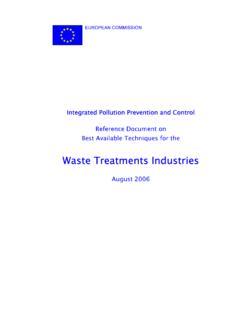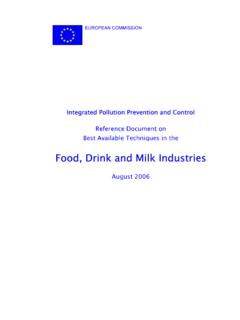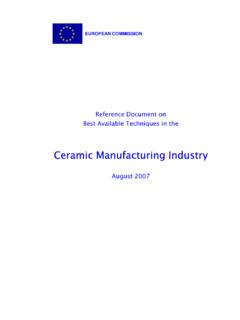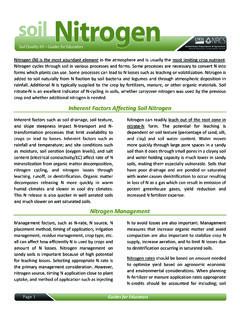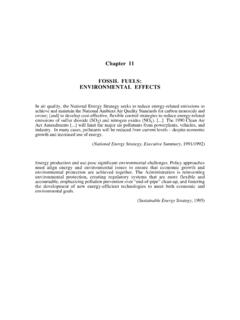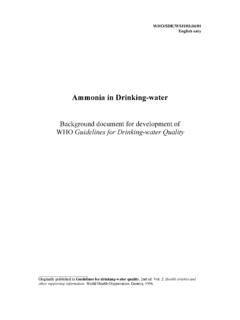Transcription of Integrated Pollution Prevention and Control Reference ...
1 EUROPEAN COMMISSION Integrated Pollution Prevention and Control Reference Document on Best Available Techniques for the Manufacture of Large Volume inorganic Chemicals - Ammonia, Acids and Fertilisers August 2007 This document is one of a series of foreseen documents as below (at the time of writing, not all documents have been finalised): Reference Document on Best Available Techniques .. Code Large Combustion Plants LCP Mineral Oil and Gas Refineries REF Production of Iron and Steel I&S Ferrous Metals Processing Industry FMP Non-ferrous Metals Industries NFM Smitheries and Foundries Industry SF Surface Treatment of Metals and Plastics STM Cement and Lime Manufacturing Industries CL Glass Manufacturing Industry GLS Ceramic Manufacturing Industry CER Large Volume Organic Chemical Industry LVOC Manufacture of Organic Fine Chemicals OFC Production of Polymers POL Chlor Alkali Manufacturing Industry CAK Large Volume inorganic Chemicals - Ammonia.
2 Acids and Fertilisers Industries LVIC-AAF Large Volume inorganic Chemicals - Solid and Others industry LVIC-S Production of Speciality inorganic Chemicals SIC Common Waste Water and Waste Gas Treatment/Management Systems in the Chemical Sector CWW Waste Treatments Industries WT Waste Incineration WI Management of Tailings and Waste-Rock in Mining Activities MTWR Pulp and Paper Industry PP Textiles Industry TXT Tanning of Hides and Skins TAN Slaughterhouses and Animals By-products Industries SA Food, Drink and Milk Industries FDM Intensive Rearing of Poultry and Pigs ILF Surface Treatment Using Organic Solvents STS Industrial Cooling Systems CV Emissions from Storage ESB Reference Document.
3 General Principles of Monitoring MON Economics and Cross-Media Effects ECM Energy Efficiency Techniques ENE Executive Summary Large Volume inorganic Chemicals Ammonia, Acids and Fertilisers i EXECUTIVE SUMMARY The BAT (Best Available Techniques) Reference Document (BREF) entitled Reference Document on Best Available Techniques for the Manufacture of Large Volume inorganic Chemicals Ammonia, Acids and Fertilisers reflects an information exchange carried out under Article 16(2) of Council Directive 96/61/EC (IPPC Directive). This executive summary describes the main findings, a summary of the principal BAT conclusions and the associated consumption and emission levels.
4 It should be read in conjunction with the preface, which explains this document s objectives; how it is intended to be used and legal terms. It can be read and understood as a standalone document but, as a summary, it does not present all the complexities of this full document. It is therefore not intended as a substitute for this full document as a tool in BAT decision making. Scope of this document This document targets the following sections from Annex 1 to the IPPC Directive: (a) ammonia, hydrogen fluoride (b) hydrofluoric acid, phosphoric acid, nitric acid, sulphuric acid, oleum phosphorus-, nitrogen - or potassium-based fertilisers (simple or compound fertilisers).
5 Although the main use of ammonia, nitric acid, sulphuric acid and phosphoric acid is the downstream production of fertilisers, the scope of this document is not restricted to the manufacture of fertiliser grade products. By addressing the items listed above, the scope of this document includes the production of synthesis gas for the production of ammonia and the production of sulphuric acid based on SO2gases from various processes, SO2gases from non-ferrous metals production or regeneration of spent acids. However, specific and in-depth information on the production of non-ferrous metals can be found in detail in the BREF on Non-ferrous Metals Industries.
6 I. Overview The fertiliser industry is essentially concerned with the provision of three major plant nutrients nitrogen , phosphorus and potassium in plant available forms. nitrogen is expressed in the elemental form, N, but phosphorus and potash may be expressed either as the oxide (P2O5, K2O) or as the element (P, K). Sulphur is also supplied in large amounts, partly through the sulphates present in such products as superphosphate and ammonium sulphate. Secondary nutrients (calcium, magnesium, sodium and sulphur) may be supplied incidentally as a result of the production process and its raw materials.
7 Micro-nutrients (boron, cobalt, copper, iron, manganese, molybdenum and zinc) can be incorporated into the major fertilisers or supplied as speciality products. 97 % of nitrogen fertilisers are derived from ammonia and 70 % of phosphate fertilisers are derived from phosphoric acid. NH3, HNO3, H2SO4and H3PO4belong to the quantitatively most important industrial chemicals and are mainly used for the production of fertilisers, but also for various other process, in chemical industry. However, HF production is not typically associated with fertiliser production, and main applications are as a raw material for the production of fluorocarbons, and in the steel, glass and chemical industries.
8 Figure I gives an overview of the boundaries and links between the LVIC-AAF industries. Accordingly, it is no surprise that often a suitable combination of productions (and not only fertiliser production) is carried out on one Integrated site, typically focused on the production of nitrogen -based fertilisers or phosphate fertilisers. ExecutiveSummaryiiLargeVolumeInorganicCh emicals Ammonia,AcidsandFertilisersAmmoniaNH3 NitricacidHNO3 SulphuricacidH2SO4 PhosphoricacidH3PO4 UreaUANANCANNPKCN4)HydrofluoricacidHF2)S SP/TSPPAPRR ockgrindingNH3H3PO4H2SO4 SSP/TSPG round phosphate rockCaCO31)ANANHNO3 Melamine3)NH3CO2CO2 Methanol3)AlF33)H2 SiF6 PhosphaterockAirH2 OLimestoneordolomiteFluorsparSO2H2 OAirAirHydrocarbonsH2 OFigureI.
9 OverviewofboundariesandlinksbetweentheLV IC-AAFindustries1)onlywithNPKproductionu singthenitrophosphateroute2)nottypically producedonfertilisersites3)notdescribedi nthisdocument4)CNisCa(NO3)2,andisalterna tivelyproducedbyneutralisationofHNO3with lime(notdescribedinthisdocument)Executiv e Summary Large Volume inorganic Chemicals Ammonia, Acids and Fertilisers iii II. Production and environmental issues Generally, LVIC-AAF production is carried out in dedicated equipment and specific processes which are a result of decades of development. However, NPK, AN/CAN and phosphate fertilisers can be produced in the same line of equipment and abatement system.
10 The production capacities generally vary from some hundred to up to more than 3000 tonnes per day. The nitrogenous fertiliser plant is especially a major consumer of energy for meeting various heating requirements and mechanical energy for driving different equipment, such as compressors, pumps and fans. Often, the bigger equipment is driven by steam turbines and the smaller one by electrical motors. Electrical power is taken from the public grid or generated on-site. The steam is supplied by boiler plants, cogeneration plants or is produced in waste heat boilers using energy from ammonia, nitric acid or sulphuric acid production.




